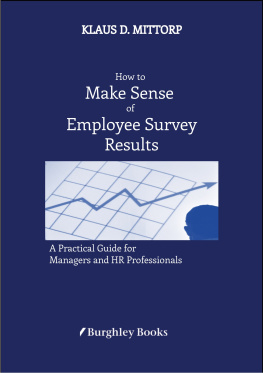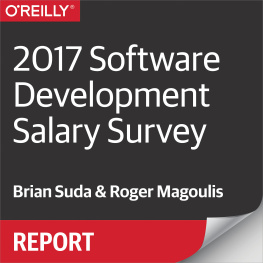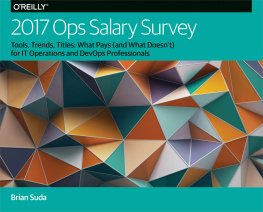
About this Book
Employee surveys represent an established tool for many executives and HR professionals alike. However, there is often a lack of orientation when it comes to interpreting the results. What does a certain result mean? The same number can be excellent, good, average, bad or even alarming. This is where this book comes in. It offers background information on all essential dimensions of a survey and provides concrete advice on interpretation. This makes it a valuable aid for all those who have to work practically with employee survey results.
About the Author
Klaus D. Mittorp served as an HR executive for both a Euro-STOXX company and a family-run, medium-sized 'hidden champion'. He also worked for almost a decade as Senior Vice President in a large international management consultancy. During his career he has designed and implemented hundreds of employee surveys and dealt intensively with the topic. He has also published internationally on the subject.
2022 Klaus D. Mittorp
The moral right of the author has been asserted.
Cover: Bernard Hermant (Unsplash)
Published
and printed by: | Burghley Books an imprint of tredition GmbH
Halenreie 40-44
D-22359 Hamburg |
ISBN: | Softcover | 978-3-347-60589-3 |
e-Book | 978-3-347-60595-4 |
Contact: autor@adexec.com
All rights reserved. Without limiting the rights under copyright reserved above, no part of this publication may be reproduced, stored in or introduced into a retrieval system, or transmitted, in any form, or by any means (electronic, mechanical, photocopying, recording or otherwise) without the prior written permission of both the copyright owner and the publisher of this book.
Contents
Preface
The World of Employee Surveys
The Market
The Providers
External Reporting (Capital Markets)
Press
Politics
Framework
Types of Survey
Specific Surveys
Generic Surveys
Implementation
Survey Timing
Survey Questionnaire
Anonymity
Scale
Business Success
Link to Performance Management
The Model
Reasons for Having Models
Common Models
Unexpected Events
Reading and Understanding Results
Participation (Response Rate)
Whats in a Number?
Agreement Levels
Indices
Putting Results into Context
Trends
Benchmarks
Internal Comparison
The Story-Line
Segmentation
Errors
Charts and Graphs
Driver Analysis
Survey Dimensions in Detail
Engagement
Enablement / Working Environment (incl. Empowerment)
Pride
Extra Mile
Employee Retention
Employer Image
Development Opportunities
Communication/ Information
Daily Emotions
Pay
Respect and Recognition
Collaboration
Well-Being
Leadership
Performance Management
Innovation / Future prospects
Significance of Scores
Blind Spots
Span of Control
Employee Preferences
Cultural Aspects
Engagement
Enablement
Risk of Unwanted Staff Loss
Well-Being
Industries
Incorrect Answers
Religion
Operational Risk
What Managers Can Achieve
Potential Impact
Real Impact
Final Considerations
References
Index
Preface
Y our organisation has conducted an employee survey (yet again, maybe), either as an ad-hoc initiative or as monitoring of what today is often referred to as the "employee experience".
There has been (mainly optimistic) institutional communication from top management on the overall results and as a manager you now receive reports with the data for your area of responsibility.
Maybe you are even provided access to a whole database with your numbers. In any event you are confronted with an overwhelming plethora of (small) pieces of information.
Sounds familiar?
Or maybe you work in HR. Colleagues from your own area have conducted the survey and now you stand in front of your internal clients with the survey results without really having all the background information you would desire.
Whatever your role, the expectation is that you appropriately deal with the situation for the entire firm or, at least (often significant), parts thereof.
The survey project team and possibly external consultants that may have been engaged in the process already consider their mission as largely accomplished. At this point their focus is likely to be on putting in place monitoring measures for tracking forthcoming progress on action supposed to be derived from the survey.
However, you dont constantly work with surveys, and with the mounting time and pressure you have little chance of dealing with matters other than fairly generically. And at some point, your bosses will want to hear what you have done since the survey.
Under such circumstances it is often difficult to obtain sound advice.
It is, in fact, all but obvious whether it is a good or bad result if 70 % of your people are proud to work for your company. It can be an equally arduous task to capture the true meaning of the various indices that are calculated from the survey.
I have repeatedly seen how seasoned managers and HR professionals easily struggle with the information coming from a seemingly confusing flow of employee survey data.
This was the reason for writing this book: helping you to see the wood in spite of all the trees that you are being shown.
Drawing from my long-standing practical experience in the field, this book is intended to provide practical advice and orientation in order to make it as easy as possible to extract meaningful conclusions from employee survey results.
It also makes clear what the limitations of an employee are in spite of all the marketing rhetoric.
Based on my practical knowledge I highlight the most important aspects that are necessary to understand the results of an employee survey regardless of how it was conducted.
This includes the type of survey, the underlying survey model, the timing of the survey, the management situation prevailing at the time of conducting the survey, the cultural framework, existing expectations, the labour market situation and crucially the respective business context.
Equally important is to understand how trends of previous surveys are calculated and how benchmarking is conducted.
After a brief introduction to the world of surveys, a dedicated section of the book deals with each of these aspects, highlighting interactions in a comprehensible and precise way and explaining how tangible insights can actually be extracted from the results.
In order to make it as helpful as possible for practitioners, where appropriate, I have supplemented the information in the book with concrete practical tips that stem from many years of personal experience.
The book is therefore intended as a practical aid for all managers and HR professionals who have to work concretely with employee survey results.
It offers well-founded background information and gives numerous practical suggestions for interpretation. The aim is to fill the existing gap in the literature currently available on the subject, which focuses either on the design and implementation of surveys or on the ways to derive follow-up action and implement it as part of change management initiatives.
The World of Employee Surveys
N owadays it is not unusual for managers or HR professionals to come across an employee survey, even in small or medium sized companies. This tool has, in fact, become fairly popular over the last decades and is now a regular standardised feature for most organisations.
Next page








